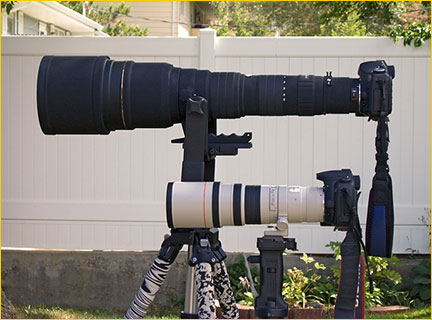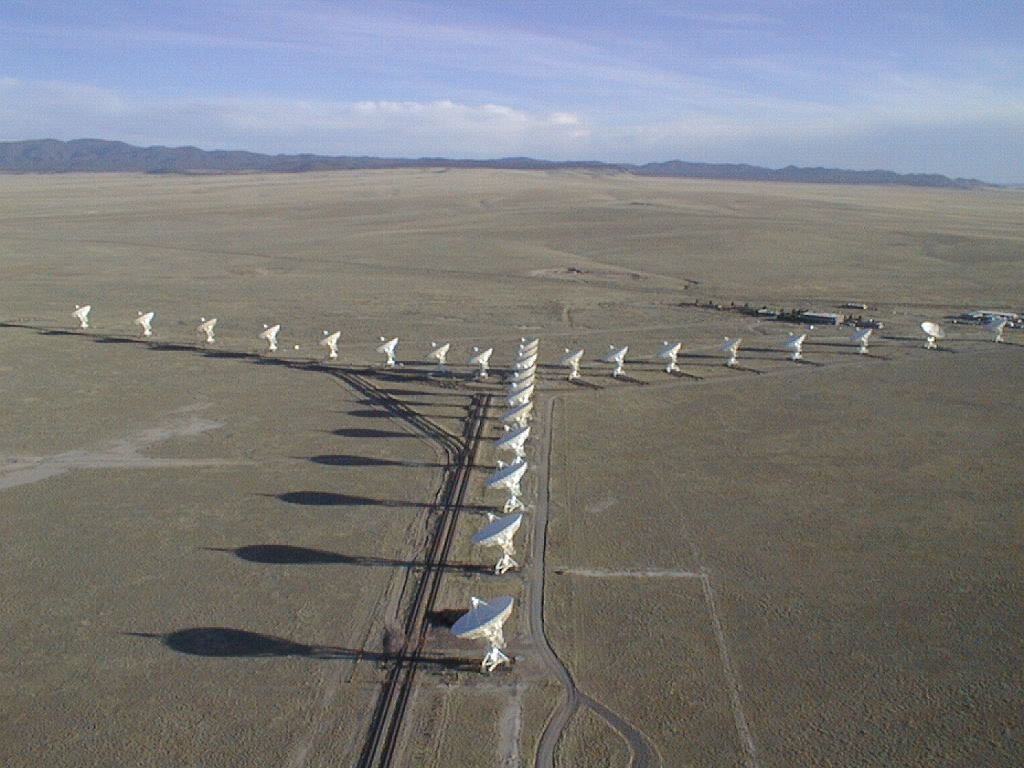Physicist: When talking about telescopes there are two quantities to take into account; the “light gathering power” and the “resolving power” of the telescope. “Light gathering power” is just how much light can be collected by the telescope. “Resolving power” is a measure of the smallest angle that the telescope can reliably detect.

Telephoto lenses need to be large because the amount of light that bounces off of a distant object and that then goes through the lens is fairly small. Being wide means they can gather more light. They need to be long for other, more subtle, reasons.
Because light is a wave it has a way of spreading out (technically: diffracting). The smaller the telescope the more the waveness becomes a problem. If the angle between two distant points is θ, the light in question has a wavelength of λ, and the size of your telescope is D across, then the smallest resolvable angle is approximately .
What’s a little weird is that this D isn’t just limited to the size of the mirror or lens of a single telescope. By cleverly networking telescopes together you can make them act like a single large telescope.

The VLA, or “Very Large Array”, was named in honor of Professor Deirdre Von Verylarge. By combining information from all of these radio-telescopes together they behave like one very large telescope that is effectively 36km across (the dishes are mobile and can be separated by at most 36 km).
Coincidentally, something that’s a large distance L away, and that’s a size S across, takes up an angle of approximately . So, if you want to be able to see something, you need
.
Visible light has a wavelength of about half a micrometer (one two-millionth of a meter), people are about a meter across (assuming a spherical person), and the Earth is about 13,000,000 meters across. So, using ground-telescopes that are perfectly constructed and networked, we could spot something person-sized from about 1/400th of a light year away, or about double the distance to Pluto. For comparison, the distance to the nearest star is about 4 light years. So, using ground based telescopes we can’t come even remotely close to seeing a person standing around on a planet in another solar system.
The nearest known, reasonable, candidates for being an Earth-like planet (as of April 2013) are about 20 light years away (HD 20794 d, Gliese 581 c, and Gliese 667C c). Spotting dudes and ladies on one of these worlds requires, at minimum, a telescope array that’s at least 100 million km across. That’s an array more than half the size of Earth’s orbit. The good news is that an array like that (under absolutely ideal circumstances) isn’t that difficult to create. Setting aside that the telescopes would each need to be essentially perfect for their size (Hubble-quality), all we’d need to do is set them up in solar orbits about the size of Earth’s orbit. This is a lot easier than sending them to another planet, and about as hard as sending them to crash on the Moon.
So, assuming that we could set all that up, the problem stops being one of resolving power, and becomes one of light-gathering power.
On a sunny day we’re hit by about 1021 (1,000,000,000,000,000,000,000) photons (give or take) every second. Assuming that a fair fraction of those escape into space, then that number, which seems large, is all that distant aliens have to work with. Over 20 light years that scant 1021 photons means you would need a telescope array with an area of more than 500 million square kilometers to catch just one photon per second. That’s the size of the surface area of Earth. In the mean time there’s a lot of other light flying around, and single photons are pretty hard to detect so… the signal-to-noise ratio would be small.
Creating an array capable of seeing big stationary things like rivers and mountains on other worlds wouldn’t be too difficult, because you can just use tremendously long exposures to overcome the whole light-gathering issue. This is a pretty standard trick in astronomy; the Hubble Deep Field took a more than a week of total exposure time. There would be some issues with the fact that those distant planets are moving and whatnot, but there are clever ways around that too.
People, and probably aliens too, move around a lot. So if you want to get a picture of one, you need the exposure to take less than, say, a second. Unless you catch E.T. literally napping. I would wildly guestimate that you’d need at least a few thousand photons per second to overcome the signal noise enough to say for certain that you’re looking at something real.
So, to answer a somewhat more detailed question; to get a picture of an alien that’s person-sized, standing on a world 20 light years away, so that it takes up one pixel in the image, using an exposure time of about one second, would require an array of telescopes with exposed mirrors and lenses with an area totaling more than several thousand times the Earth’s surface area and spread out over a region about the size of Earth’s orbit.
This isn’t technically impossible, but it would be “expensive”, and would require substantially more materials than are likely to be reasonably found in our solar system. It probably isn’t worth it to get a blurry, tiny picture of some alien picking it’s nose 20 light years away and 20 years ago.
Of course, if you wanted to see farther, you’d need a much larger telescope array.







“using ground-telescopes that are perfectly constructed and networked, we could spot something person-sized from about 1/400th of a light year away, or about double the distance to Pluto”
We seem unable to even photograph Pluto, beyond a few grainy pixels… how could we possibly resolve anything person-sized from this distance? Or how far from “perfectly constructed and networked” are our telescopes, at this time?
We also have atmosphere to deal with, light gathering difficulties, noise, and whatnot. The limits described in the post are extreme fundamental lower limits.
Interesting. I didn’t know the VLA was named after Deirdre.
But seriously, why haven’t we made a telescope by linking smaller telescopes in Earths orbit? That seems like something we are capable of. Wouldn’t it allow us to observe our own system pretty well without having to send a probe to each planet? Or is it just not worth it?
It seems to me that probability comes into play someplace here. Surely every photon that emanates from some person on some planet out there toward whatever array we might have in place to receive it, doesn’t make it. It would also seem that certain conditions would lead to some clustering that would provide some better than normal chance of their being recognized. I know that I often see things I have missed with my first scan. And while this can be attributed to my animal weaknesses and strengths, I would think there would be something similar taking place with the complex system you describe.
Excellent article! I like that you linked to xkcd, if only Randall would return the favor, eh? 😛
i go with the physicist he is right
because physicist depend on practice and experiment.
Just zoom in !
If the CIA can read a newspaper from space then how come we can’t get a close up full hd image of a airplane or UFO that’s visible to the naked eye? Should be able to see the pilots face surely ?
There’s got to be some better way of knowing about things that are very far away, or very small. Photons, though probably the easiest way to detect things, and certainly the best way known so far, have so many limitations.
Is it possible there’s some method of reversing diffraction? Surely if you know in what way the light is diffracting, then taking in the picture, a computer can calculate what the image should look like.
A note for those wondering about the “telescope with an earth-sized orbit”:
We have done this. To make a telescope that large, you need smaller telescopes to take an image pointing in the same direction from both sides of the sun.
We didn’t actually send a telescope opposite the earth. We take a photo in the spring, wait, and take another photo in the fall (6 months apart). In that time, the earth switches sides for us. Much cheaper.
Of course, this method only works for things that don’t move “alot” over 6 months. So it wouldn’t work for the human-sized objects discussed in the article.
I would prefer a relay-lens telescope, that re-images the person over and over until it gets to your eyepiece. Think of it as a super-long telephoto lens.
is darkness having speed…..?
Instead of building the whole lens of the telescope, we could build only several small parts of the lens. I.e. we don’t need the whole lens for the image. Could we place several space stations apart from each other in space, so very well synchronized that they will constitute distant bits of a gigantic lens?
The obvious solution would be to drop-off a big number of very large lens-satellites as the Earth rotates around the sun for a year (or more). The moon (+earth) could probably be used as a sling shot to place each satellite into a solar stationary orbit As is done, each individual lens fragment would synchronously target the desired object and a composite could then be made up by combining the assembled images. Because each lens-satellite would be the same, mass production could cut costs considerably. One could keep adding more and more over a number of years as resources allow.
What is this theory called?
Because I have been very intrigued and curious about it but cannot find it anywhere on the internet because well i dont know what it is called.
So is there a name for this theory and if so please contact me ASAP.
Thank you
In theory, we should be able to use the sun as a gravity lens. The focal point would probably be exterior to our solar system and would take an extra ordinary effort to align with, but may be easier then a trip to the planet.